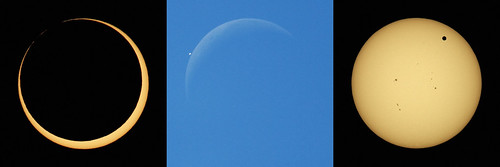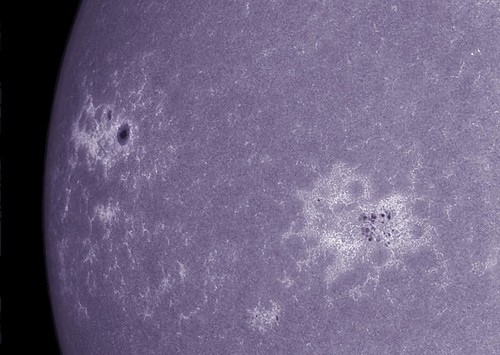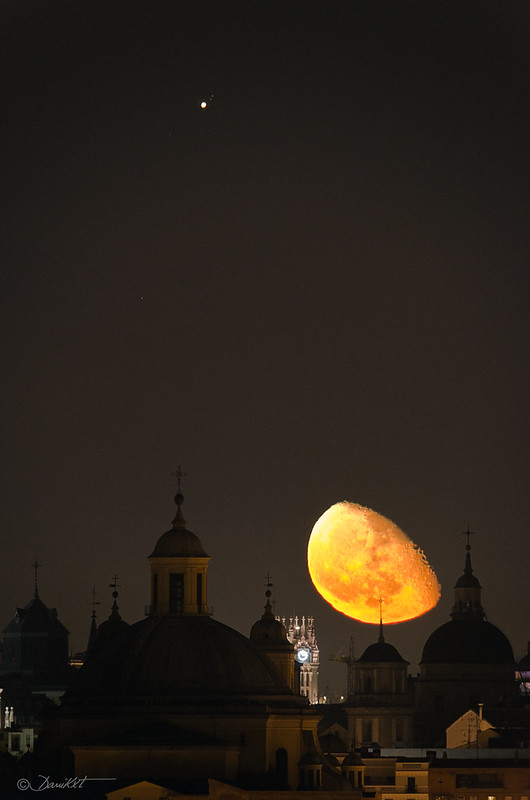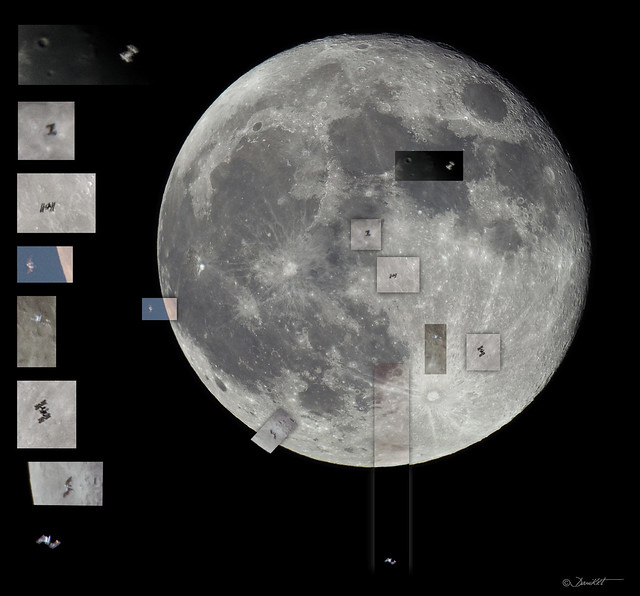Page 5 of 9
Re: Recent Submissions: 2012 October
Posted: Fri Oct 12, 2012 10:58 am
by Rothkko
...

- Vegas Altas del Guadiana. Spain. 2012-10-10
Re: Recent Submissions: 2012 October
Posted: Fri Oct 12, 2012 2:53 pm
by Rothkko
working

- Almoharín. Spain. 2012-10-10
on these lands will rise 20 meters of water in what will be in a few years the reservoir Búrdalo
sobre estas tierras se levantarán 20 metros de agua en lo que será en pocos años el embalse del Búrdalo
Re: Recent Submissions: 2012 October
Posted: Fri Oct 12, 2012 4:47 pm
by Robert Howell
The Aurora extended to southern Montana and into Wyoming just before and after midnight on Sept 30/Oct 01.
The rising full moon spotlighted the erupting White Dome Geyser in Yellowstone National Park.
It is rare but not unusual for the Northern Lights to be seen at this latitude.
Occurring as the full moon rose and the geyser erupted just added to the splendid display.
Re: Recent Submissions: 2012 October
Posted: Fri Oct 12, 2012 5:08 pm
by Siggi
NGC281 - The Pacman Nebula
http://www.astroimages.de
Copyright: Siggi Kohlert, Ralf Mündlein
Higher Res at
http://www.astroimages.de/en/gallery/NGC281-ccd.html
Thanks for looking
Cheers
Siggi
Re: Recent Submissions: 2012 October
Posted: Fri Oct 12, 2012 10:44 pm
by nicola montecchiari
M46 and M47
http://www.skymonsters.net
Copyright: Nicola Montecchiari
Re: Recent Submissions: 2012 October
Posted: Sat Oct 13, 2012 8:52 am
by Florian Kainz
 Three Conjunctions: Sun & Moon, Moon & Venus, Venus & Sun
Three Conjunctions: Sun & Moon, Moon & Venus, Venus & Sun by
fksr, on Flickr
Annular solar eclipse as seen at Pyramid Lake, Nevada on May 20, 2012,
Venus-Moon occultation a seen in San Rafael, California on August 13, 2012, and
transit of Venus as seen in San Francisco, California, on June 5, 2012.
Re: Recent Submissions: 2012 October
Posted: Sat Oct 13, 2012 5:44 pm
by Florian Kainz
The sky on a moonless night at Lake Sonoma in California.
 Night at Lake Sonoma - Milky Way
Night at Lake Sonoma - Milky Way by
fksr, on Flickr
 Night at Lake Sonoma - Big Dipper
Night at Lake Sonoma - Big Dipper by
fksr, on Flickr
Re: Recent Submissions: 2012 October
Posted: Sat Oct 13, 2012 10:08 pm
by lizarranet
Cloudy Cepheus
Mikel Martínez.
http://fotoastro.blogspot.com
This is a small part of the vast clouds in Cepheus and Cassiopea
[attachment=0]martinez.jpg[/attachment]
http://3.bp.blogspot.com/-tVYFzVZ9K2c/U ... eo+red.jpg
Higher res here:
http://www.astrobin.com/full/22191/?mod=none
Regards,
Mikel
Re: Recent Submissions: 2012 October
Posted: Sun Oct 14, 2012 8:44 am
by hardcity
Re: Recent Submissions: 2012 October
Posted: Sun Oct 14, 2012 9:24 am
by Ann
I have really stopped commenting on images posted here, but...
Rothko, I really like your "tree and clouds" photos. Robert Howell, that's a very striking image of a geyser erupting and the sky being aflame with aurorae at the same time. nicola montecchiari, I really like your portrait of M46 and M47. Your picture brings out the difference between these two clusters perfectly. Relatively nearby M47 is quite similar to what the Pleiades would be, if the Pleiades had not been immersed in a passing dust cloud. More distant M46 is an older cluster and very rich. The planetary nebula seen in the cluster may be a foreground or a background object, but it is still very interesting.
Florian Kainz, I like both your pictures very much.
hardcity, your picture is really the reason for my post. I have said many times here at Starship Asterisk* that I don't really "like" planetary nebulae, because I don't understand their colors. I don't "know" what their colors are, because I have never seen color in a planetary nebula, and it bothers me that the colors of planetary nebulae in pictures are so unpredictable and different.
Well, you picture is not only extremely beautiful as far as the colors go, but the structures it reveals are also absolutely fascinating. I just love your picture!

Ann
Re: Recent Submissions: 2012 October
Posted: Sun Oct 14, 2012 11:51 am
by Rothkko
thank you, Ann.
Re: Recent Submissions: 2012 October
Posted: Sun Oct 14, 2012 12:27 pm
by Acamacho
Orion Nebula:
Copyright: Angel Camacho
Higher res here:
http://farm9.staticflickr.com/8184/8082 ... 940a_k.jpg
Re: Recent Submissions: 2012 October
Posted: Sun Oct 14, 2012 1:19 pm
by hardcity
Thank you for your comment, Ann. I'm glad you like my photo! As you noticed, I wanted to get closer to the RGB colors traditional for a more natural effect. I hope to be here a little. (sorry for my poor english).
Re: Recent Submissions: 2012 October
Posted: Sun Oct 14, 2012 2:19 pm
by Stefano79
Bhautik Joshi wrote:Rainbow Angel
I think this is a neat demonstration of three aspects of atmospheric physics here - the high-G turn slowed the plane enough to permit a sharp photograph, which in turn caused a region of high pressure on the top surface of the plane which condensed moisture out of the air for the ethereal vapor trails, which in turn scatter sunlight from behind creating a transient rainbow
 http://www.flickr.com/photos/captin_nod/8059689951/
http://www.flickr.com/photos/captin_nod/8059689951/
Copyright: Bhautik Joshi 2012
This shot is a kind of magic!!!
Great job
Re: Recent Submissions: 2012 October
Posted: Sun Oct 14, 2012 9:42 pm
by avdhoeven
Recently I have been working some more on the Heart Nebula. This is my result for now...
Full resolution
Re: Recent Submissions: 2012 October
Posted: Sun Oct 14, 2012 10:40 pm
by nuclearcat
Descending Big Dipper and Air Glow.
Copyright: M. Raşid Tuğral
Re: Recent Submissions: 2012 October
Posted: Mon Oct 15, 2012 2:47 am
by dani caxete
Re: Recent Submissions: 2012 October
Posted: Mon Oct 15, 2012 3:39 am
by bystander
Thierry Legault wrote:A night at Wallaman Falls, Queensland, Australia. A bright meteor crosses the Milky Way, while the light of the gibbous Moon causes a moonbow with the waterfall.
http://legault.perso.sfr.fr/wallamanfalls.jpg
Thierry Legault: Moonbow and Meteor over Australia’s Wallaman Falls
Universe Today | Nancy Atkinson | 2012 Oct 14
Re: Recent Submissions: 2012 October
Posted: Mon Oct 15, 2012 11:16 am
by frikosal
Pointing to the center of the Milky Way
(c) Manel Soria
http://www.facebook.com/frikosal
Re: Recent Submissions: 2012 October
Posted: Mon Oct 15, 2012 8:10 pm
by Rothkko
at sunset...
energy

- Mérida, Spain. 2012-10-15
Re: Recent Submissions: 2012 October
Posted: Mon Oct 15, 2012 10:22 pm
by JULIO__CESAR
Green flash from Cadiz, Spain captured last october 9th, 2012. Sequence of 10 frames taken just before the green flash showed.
[attachment=0]greenflash_julio.jpg[/attachment]
http://www.astrosurf.com/juliocesar/Ray ... _Marco.jpg
Re: Recent Submissions: 2012 October
Posted: Mon Oct 15, 2012 10:42 pm
by nicola montecchiari
Ann wrote:nicola montecchiari, I really like your portrait of M46 and M47. Your picture brings out the difference between these two clusters perfectly. Relatively nearby M47 is quite similar to what the Pleiades would be, if the Pleiades had not been immersed in a passing dust cloud. More distant M46 is an older cluster and very rich. The planetary nebula seen in the cluster may be a foreground or a background object, but it is still very interesting.
Ann
Thanks a lot Ann, I normally look for the best matching color balance for my stars. Not an easy task though

Re: Recent Submissions: 2012 October
Posted: Mon Oct 15, 2012 11:08 pm
by Petr H.
How would the Betelgeuze supernova look like?
Copyright: Petr Horálek, NASA/JPL-Caltech/STScI/CXC/SAO
The hot candidate fot the further supernova in the sky is massive star Betelgeuze in Orion shoulder. The star is around 15 times heavier than our Sun and it should end its life with intensive collapse and following exposion like supernova II. No one knows when it actually happens. But it could be in next 1000 years. If the supernova occurs, the people will enjoy intensive bright star - almost as bright as the Moon in first quarter. The star could be visible even in broad daylight and during the night there will be significant shadows of buildings and trees. This episode of the Betelgeuse will take 2-3 months. Then - after next thousands years people will observe odd nebula in the Orion shoulder similar to the one in Cassiopea constellation, which is remain of the Kepler supernova of year 1604. Inside the nebula would stay remain of the Betelgeuze core - neutron star or pulsar. The image was taken in Ondrejov observatory (30th January 2012 during moonlit of first-quarter Moon, which is out of the image). Included remain is of photography of SN1604 (Cass A) captured by HST, Chandra and Spitzer Space telescope. Colors of the nebula are desaturated to make it real, how the human eyes will see it in the nightime.
Higher dimension:
http://www.astronom.cz/horalek/gallery/ ... 1000px.jpg
Higher dimension:
http://www.astronom.cz/horalek/gallery/ ... 1000px.jpg
Re: Recent Submissions: 2012 October
Posted: Tue Oct 16, 2012 3:10 am
by Sullij
Calcium K line Sunspots 1589 AND 1591 (SOHO)
Copyright: Joe Sullivan, Charlie bates Solar Astronomy Project (CBSAP)
 1589 AND 1591 1390
1589 AND 1591 1390 by
Sullij1, on Flickr
http://www.flickr.com/photos/49217915@N ... otostream/
Re: Recent Submissions: 2012 October
Posted: Tue Oct 16, 2012 11:14 am
by SkyViking
Deep Image of the Cartwheel Galaxy ESO 350-40
http://www.rolfolsenastrophotography.com
Copyright: Rolf Wahl Olsen
Link to large size image
Link to original size image (2.5MB) (Check this one to see all the details in the galaxy itself)
Surprisingly there are only a couple of amateur images of this galaxy. It is rather small though, at 0.6 x 0.6 arcminutes in diameter. I was pleasantly surprised to find that the background is bursting with distant galaxy clusters, actually most of the faint specks in this image are galaxies, not stars...
The Cartwheel Galaxy itself is a distant galaxy located 400 million light years away in the southern constellation Sculptor. It features a unique ring structure, most likely as a result of a head-on collision 200 million years ago with a smaller intruder galaxy that passed though the very core of the larger galaxy. The density wave set in motion by the passage of the intruder is visible as intense starburst activity along the edge of a massive ring that is slowly making its way outwards from the centre, like a ripple on a pond.
The galaxy is part of a small group of four, with the other members being the smaller blue and yellow galaxies right next to the Cartwheel and another companion a little further north (down). The latter is believed to be the intruder galaxy. In fact, high resolution radio observations have identified a trail of neutral hydrogen gas between the Cartwheel and the intruder, strongly suggesting that this is indeed the culprit now fleeing the scene.
Images from the Hubble Space Telescope show the bright knots in the ring to be giant clusters of super luminous young blue stars. These bright stars will live and die within a few million years, well before the density wave has moved on, and new stars will continue to be born of the same recycled matter in this chaotic setting of intense starburst activity and cataclysmic supernovae brought about by a cosmic encounter 200 million years ago.
Eventually the wave will dissipate and fade out into the outer regions of the galaxy where the gas and dust is too thin for new stars to be born. Looking like the spokes of a giant wheel, faint spiral arms can already be seen beginning to form again after the collision. The galaxy will probably take on the form of a normal spiral again in the future.
Looming in the background of the image are large numbers and groupings of faint distant galaxies, visibly clumping together and forming the large scale superstructure of the Universe. Many of these lie in the neighbourhood of the Sculptor Wall, a gigantic structure of galaxy clusters that stretches outwards for more than a billion light years.
Image details:
Date: 22nd September and 9th/10th/11th October 2012
Exposure: LRGB: 630:70:65:65m, total 13hrs 50mins @ -30C
Telescope: 10" Serrurier Truss Newtonian f/5
Camera: QSI 683wsg with Lodestar guider
Filters: Astrodon LRGB E-Series Gen 2





